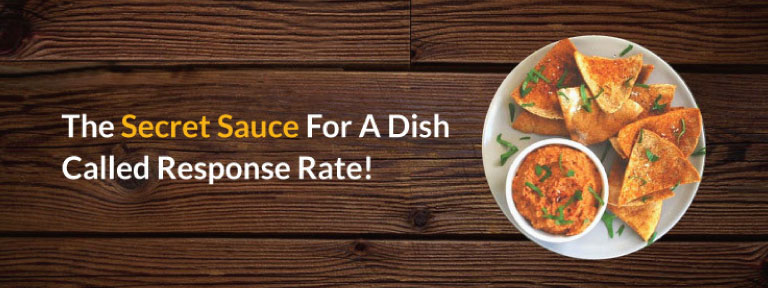Vivek Pai: The Secret Sauce For A Dish Called Response Rate
VOICE OF AMBASSADORS
The Secret Sauce For A Dish Called Response Rate

I am a hardcore foodie! If there is one thing that catches my attention every time while reading a menu, it’s “secret sauce”. The Secret sauce is what makes a dish magical!
Response rates have the same kind of effect on conversations or communication that brands have with their consumers. You may have the best creative (you may even win a few awards for it), but unless you get the secret sauce right, the magic ain’t happening.
But worry not, I will be your chef for the day and will give you the recipe for the secret sauce called “Response rate”.
Just like in any recipe both the ingredients and the steps play an important role in the final outcome.

Ingredients:
- Context to the communication
- The communication channel
- The date and time when the communication is sent
- First impression of the communication
- Content of the communication
- Call to action
- Customer’s WIIIFM (what is in it for me)
- Closing the loop
Steps:
- Getting the content right
- Mapping the customer journey
- Understanding drop-offs
- Measuring drop-offs
- Improving response rates
So now that you know what it takes and what needs to be done, get your aprons on! Let the cooking begin.
Step 1: Getting the content right
The quality of the dish is going to be only as good as the quality of the ingredients that go into making it.
So before you work on anything else, you need to work on getting the content of your communication right. And this isn’t rocket science. On the contrary, it’s very simple.
Ask why the customer should be receiving the communication, not why you should be sending it!
Here are a few tips that you should keep in mind while developing content for your communication:
- KISS – Keep it short & simple
- Personalize:
- Address the customer by his or her name, and for heaven’s sake, get the name right!
- Personalize other elements that were part of the interaction that the customer had with you. This will help the customer recall the brand/interaction and will go a long way in improving response rates. E.g. Instead of “Dear customer, thank you for contacting us. Please let us know how your experience was.”, use “Dear Vivek, thank you for calling us. You spoke to Aftab. We hope your query on Forex Cards was resolved. Please let us know how your experience was.”
- Have a clear call to action – tell the customer in simple terms what you expect him or her to do after reading the communication, preferably somewhere where it is visible even without a scroll.
- WIIIFM – the reason why: The “what is in it for me” should be very clear in the communication. Why should the customer respond? What benefits will he she get? The most common WIIIFMs are:
- Incentive in terms of discounts, points, freebies, etc
- His or her opinion being heard
- Better quality service in the future
Once your communication is ready, you can review it by asking the following questions:
- Is the communication relevant to the customer?
- In what context is the customer getting this communication?
- Is this context clear in the communication?
- Is the communication simple to understand?
- Is the call to action clear in the communication?
- Is the communication short enough to retain the customer’s attention?
- What is in it for the customer to read and respond to the communication?
Now that you have the communication in place, let’s move to the next step.
Step 2: Mapping the customer journey
To be able to improve response rates, you first need to know what interventions are possible and at what time. This is what makes knowing the customer journey a game-changer.
Mapping the customer journey is simple – just put yourself in the customer’s shoes and then map the ideal path that he will have to take before achieving the end objective you want. Once this is done, identify points where the customer is likely to go off the ideal path.
Any customer who goes off the ideal path reduces the overall response rate.
These are places where you can put in communication interventions to bring the customer back on to the ideal path.
Let me take an example to illustrate this. Let’s assume I am sending an email to my boss who:
- Gets about 500 emails every day and
- Is very busy and hard-pressed for time
My end objective is to get my boss to respond to my email.
In this case, I represent the brand and my boss represents the customer.
The ideal path for my boss to respond is:
- I send the email
- The email goes from my outbox
- The email gets delivered to my boss
- My boss gets a notification on his mobile
- He clicks on the notification to see a preview of the email
- He opens the email and reads the entire contents
- He is clear what is expected of him
- He responds to my email
Now that we have mapped the customer journey, its time to understand where they may drop-off.
Step 3: Understanding drop-offs
It’s critical for you to know that with each step that you add in the customer journey, you are increasing the chance of the customer dropping off before achieving the end objective. In the example that I had taken in the above step, the following drop-offs may occur:
- I may type the email but not send it – it keeps lying in my drafts
- The email ID that I type may be incorrect
- My laptop may not have an active internet connection
- The email may land in my boss’s spam box
- My boss may see the notification/email and decide to act on it later
- My boss may open the email but not respond since he is not clear what I am expecting him to do
As you can see, the more the steps, the higher the chances of drop-offs.
The most common reasons for drop-off are:
- Poor data quality
- System issues and delays
- Communication best practices not being followed
- HTML coding best practices not being followed
Now that we have identified the drop-offs that are possible, we are ready to move to the next step.
Step 4: Measuring drop-offs
To be able to improve response rates, it’s very important to have in place a system that will help measure and report key metrics regarding your communication. Ideally, this system should also measure and report the drop-offs at every stage. Here are the metrics that you will need to track to be able to measure drop-offs end to end:
- # of customers in the data-set chosen for communication
- # of duplicates in the data-set
- # of records with incorrect contact details
- # of records with invalid contact details
- # of customers who were sent the communication
- # of communications delivered
- # of customers who opened the communication
- # of customers who clicked on the Call To Action
- # of customers who reached the landing page
- The time it took for the landing page to load
- # of customers who took the intended action on the landing page
When choosing a system that measures these key metrics, ensure that you have access to these reports in real-time. The faster you know where the drop-offs are, the faster you can react.
You are now ready for the final step.
Step 5: Improving response rates
To be able to improve response rates, you will first need to study the drop-offs and identify the areas where there is scope for improvement. Once the area is identified, you will then need to identify what interventions you will need to bring in to ensure that drop-offs are reduced. The key to success is going to be testing.
Remember that you always need to test by changing only one variable at a time.
This will help you understand what is causing the increase in response rates. Use the A/B testing and champion-challenger method to identify the variant of the communication that works the best for you.
In A/B testing, you change one aspect of the communication to test which variant performs the best. For e.g. you may test different subject lines to see which variant pulls the best open rate. Once you identify a winner, you now need to use the champion challenger method to see if you have reached optimal response.
In the champion challenger method, the winning variant of the A/B test is taken as the “Champion”. Based on what seems to have worked, you come up with a “Challenger” variant to see if you can get a better response when compared with the “Champion”.
And remember track response for the half-life of the campaign. You don’t have to wait very long to know the initial results of your communication.
In most cases you will find that 50% of the responses are got within the first 4 to 24 hrs
The half-life is a very important metric to track as this will tell you how long you need to wait to evaluate if your communication is working on not.
Now that you have all the steps, you are ready to make your own secret sauce to improve your response rate dish.
Happy cooking!
Vivek Pai is a direct & database marketing professional with a history in retail, hospitality and the services industry, experienced in product management, CRM, loyalty programmes, direct marketing, and email marketing.


